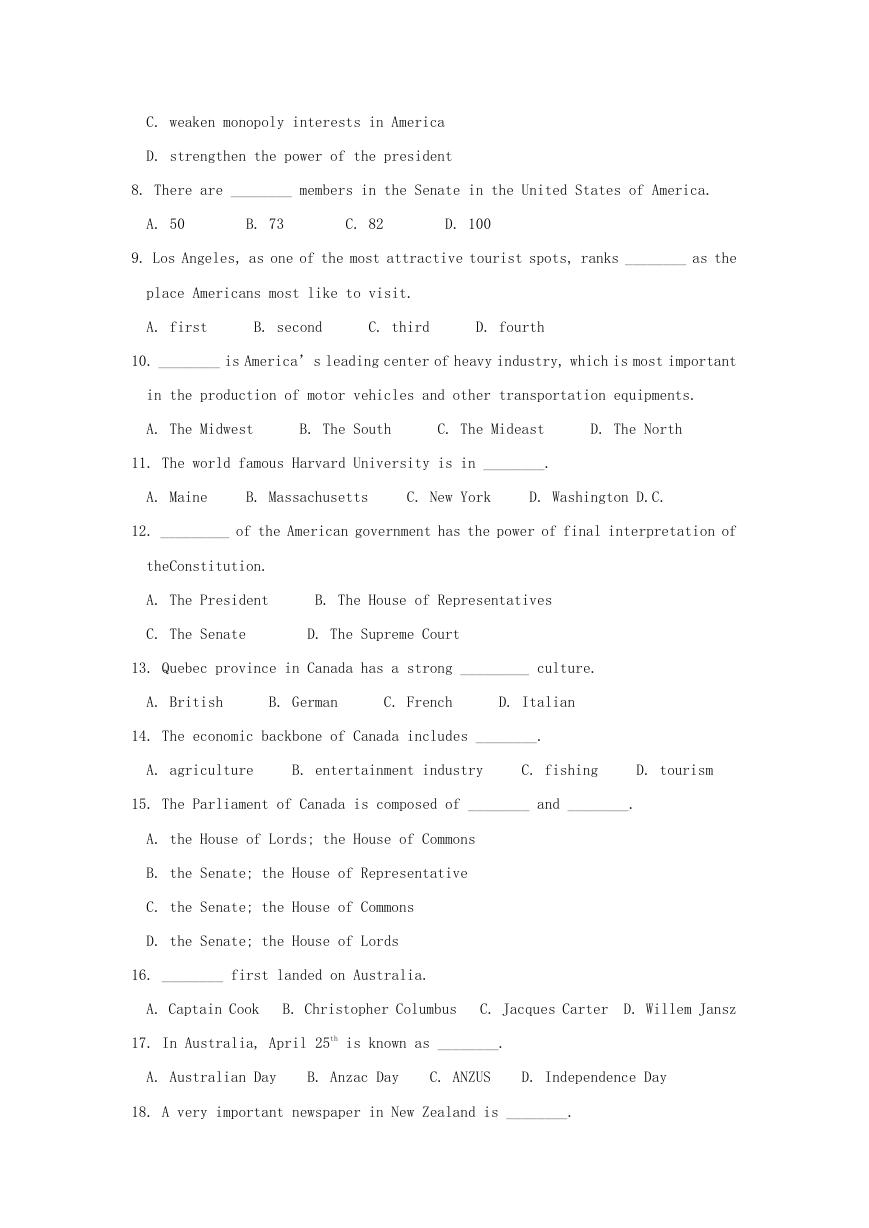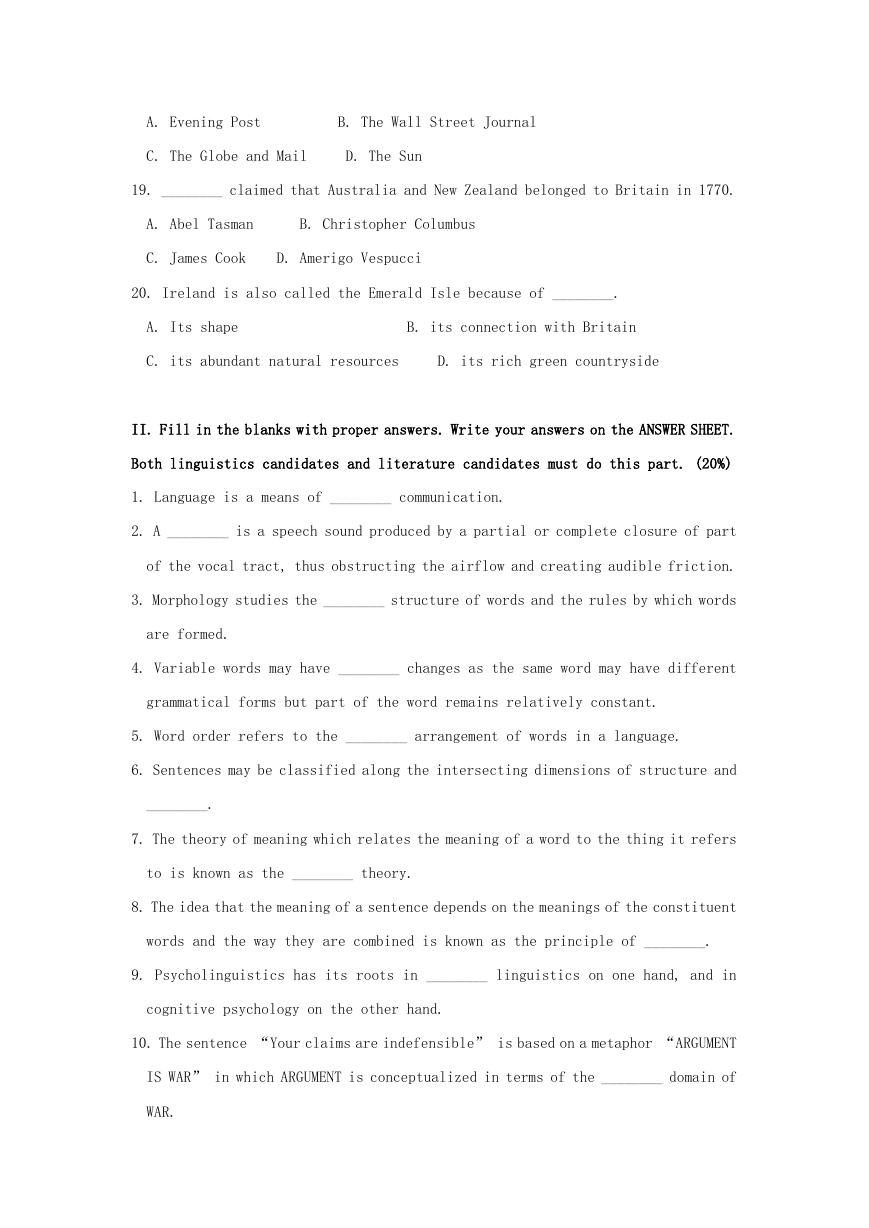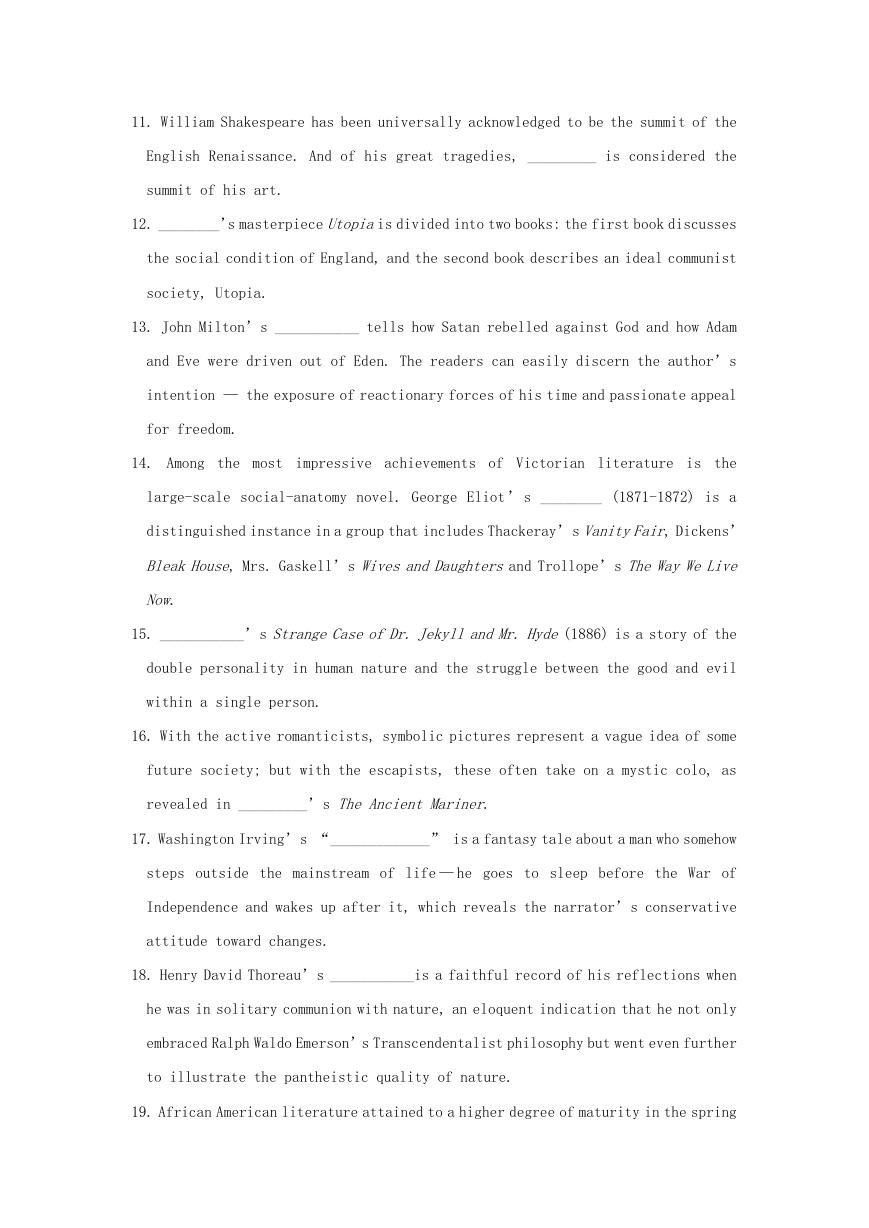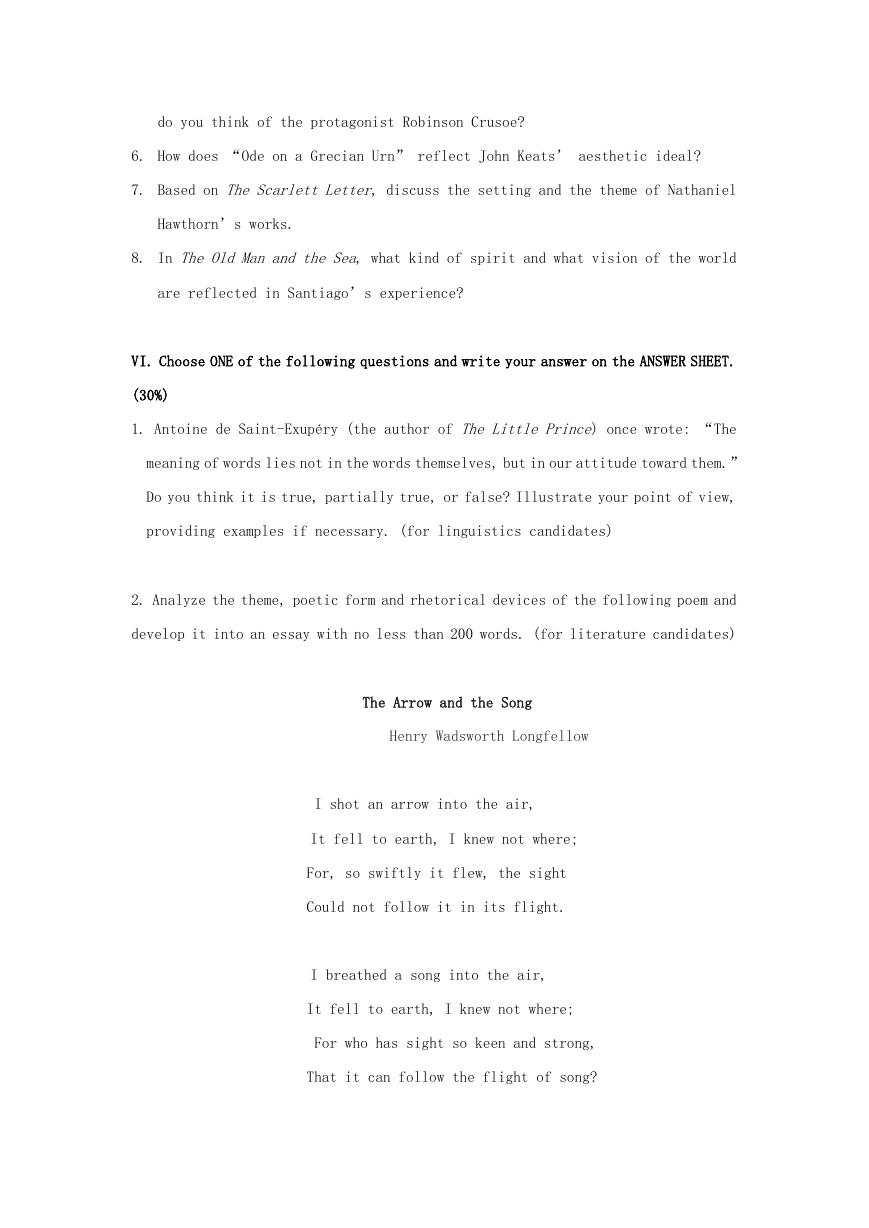2018 年广东暨南大学外国语言文学综合考研真题
招生专业与代码:外国语言文学 0502 (涵盖英语语言文学 050201、外国语言学及应用语言
学 050211)
考试科目名称及代码:808 外国语言文学综合考试
考生注意:所有答案必须写在答题纸(卷)上,写在本试题上一律不给分。
I. Multiple choices. There are 20 questions in this part. Choose the best answer
to each question. Write your answers on the ANSWER SHEET. Both linguistics
candidates and literature candidates must do this part. (20%)
1. There are altogether ________ nations within the British Commonwealth nowadays.
A. 45
B. 53
C. 55
D. 60
2. Christianity was first brought to England by ________.
A. the Romans
B. the Celts
C. the Anglo-Saxons
D. the Danes
3. _________ is not the reason for the very limited influence of Romans on Britain.
A. That the Romans treated the Britons as a subject people of slave class
B. That the Romans and Britons never intermarry during the four centuries
C. That the Romans did not like the Britons
D. That the Romans had no impact on the language or culture of ordinary Britons
4. England and Scotland are separated by ________.
A. the Thames River
B. the Clyde River
C. the Lough Neagh
D. the Hadrian’s Wall
5. In 1337 the hostility between England and ________ resulted in the Hundred Years’
War.
A. France
B. Spain
C. Russian
D. Ireland
6. In Britain only about ________ of the population are farmers but they manage 70%
of the land area.
A. 2%
B. 3%
C. 4%
D. 5%
7. The goal of Roosevelt’s New Deal was to ________.
A. save the American economic and political system
B. get America out of the depression
�
C. weaken monopoly interests in America
D. strengthen the power of the president
8. There are ________ members in the Senate in the United States of America.
A. 50
B. 73
C. 82
D. 100
9. Los Angeles, as one of the most attractive tourist spots, ranks ________ as the
place Americans most like to visit.
A. first
B. second
C. third
D. fourth
10. ________ is America’s leading center of heavy industry, which is most important
in the production of motor vehicles and other transportation equipments.
A. The Midwest
B. The South
C. The Mideast
D. The North
11. The world famous Harvard University is in ________.
A. Maine
B. Massachusetts
C. New York
D. Washington D.C.
12. _________ of the American government has the power of final interpretation of
theConstitution.
A. The President
B. The House of Representatives
C. The Senate
D. The Supreme Court
13. Quebec province in Canada has a strong _________ culture.
A. British
B. German
C. French
D. Italian
14. The economic backbone of Canada includes ________.
A. agriculture
B. entertainment industry
C. fishing
D. tourism
15. The Parliament of Canada is composed of ________ and ________.
A. the House of Lords; the House of Commons
B. the Senate; the House of Representative
C. the Senate; the House of Commons
D. the Senate; the House of Lords
16. ________ first landed on Australia.
A. Captain Cook
B. Christopher Columbus
C. Jacques Carter
D. Willem Jansz
17. In Australia, April 25th is known as ________.
A. Australian Day
B. Anzac Day
C. ANZUS
D. Independence Day
18. A very important newspaper in New Zealand is ________.
�
A. Evening Post
B. The Wall Street Journal
C. The Globe and Mail
D. The Sun
19. ________ claimed that Australia and New Zealand belonged to Britain in 1770.
A. Abel Tasman
B. Christopher Columbus
C. James Cook
D. Amerigo Vespucci
20. Ireland is also called the Emerald Isle because of ________.
A. Its shape
B. its connection with Britain
C. its abundant natural resources
D. its rich green countryside
II. Fill in the blanks with proper answers. Write your answers on the ANSWER SHEET.
Both linguistics candidates and literature candidates must do this part. (20%)
1. Language is a means of ________ communication.
2. A ________ is a speech sound produced by a partial or complete closure of part
of the vocal tract, thus obstructing the airflow and creating audible friction.
3. Morphology studies the ________ structure of words and the rules by which words
are formed.
4. Variable words may have ________ changes as the same word may have different
grammatical forms but part of the word remains relatively constant.
5. Word order refers to the ________ arrangement of words in a language.
6. Sentences may be classified along the intersecting dimensions of structure and
________.
7. The theory of meaning which relates the meaning of a word to the thing it refers
to is known as the ________ theory.
8. The idea that the meaning of a sentence depends on the meanings of the constituent
words and the way they are combined is known as the principle of ________.
9. Psycholinguistics has its roots in ________ linguistics on one hand, and in
cognitive psychology on the other hand.
10. The sentence “Your claims are indefensible” is based on a metaphor “ARGUMENT
IS WAR” in which ARGUMENT is conceptualized in terms of the ________ domain of
WAR.
�
11. William Shakespeare has been universally acknowledged to be the summit of the
English Renaissance. And of his great tragedies, _________ is considered the
summit of his art.
12. ________’s masterpiece Utopiais divided into two books: the first book discusses
the social condition of England, and the second book describes an ideal communist
society, Utopia.
13. John Milton’s ___________ tells how Satan rebelled against God and how Adam
and Eve were driven out of Eden. The readers can easily discern the author’s
intention — the exposure of reactionary forces of his time and passionate appeal
for freedom.
14. Among the most impressive achievements of Victorian literature is the
large-scale social-anatomy novel. George Eliot ’ s ________ (1871-1872) is a
distinguished instance in a group that includes Thackeray’s VanityFair, Dickens’
BleakHouse, Mrs. Gaskell’s WivesandDaughters and Trollope’s TheWayWeLive
Now.
15. ___________’s StrangeCaseofDr.JekyllandMr.Hyde(1886) is a story of the
double personality in human nature and the struggle between the good and evil
within a single person.
16. With the active romanticists, symbolic pictures represent a vague idea of some
future society; but with the escapists, these often take on a mystic colo, as
revealed in _________’s The Ancient Mariner.
17. Washington Irving’s “_____________” is a fantasy tale about a man who somehow
steps outside the mainstream of life — he goes to sleep before the War of
Independence and wakes up after it, which reveals the narrator’s conservative
attitude toward changes.
18. Henry David Thoreau’s ___________is a faithful record of his reflections when
he was in solitary communion with nature, an eloquent indication that he not only
embraced Ralph Waldo Emerson’s Transcendentalist philosophy but went even further
to illustrate the pantheistic quality of nature.
19. African American literature attained to a higher degree of maturity in the spring
�
of 1952 when __________’s InvisibleManwhich told an archetypal existential story
of modern times was published.
20. J. D. Salinger wrote one novel, ___________, an influential book to come out
of the postwar period. It depicts in eloquent language an adolescent’s disgust
and despair at the fallen state of the adult world around him.
III. Write your answers on the ANSWER SHEET. Both linguistics candidates and
literature candidates must do this part. (10%)
Section A: Decide whether each of the following statements is True or False. If
it is true, write T and if it is false, write F.
1. There are many languages in today’s world that can only be spoken, but not written.
2. Human beings are capable of making all kinds of sounds and make them systematic.
3. In most cases, the number of syllables of a word corresponds to the number of
morphemes.
4. The external syntax of a construction refers to the properties of the construction
as a part of whole.
5. The most distinguishable linguistic feature of a regional dialect is its grammar
and uses of vocabulary.
Section B: Give the author's name and indicate the genre of the following works.
6. King Lear
7. To the Lighthouse
8. "Of Studies"
9. "The Fall of the House of Usher"
10. Leaves of Grass
IV. Choose SIX from the following terms and explain them briefly. Write your answers
on the ANSWER SHEET. (30%)
1. displacement
�
2. manner of articulation
3. allomorph
4. endocentric construction
5. metonymy
6. entailment
7. American Naturalism
8. Gothic novel
9. ballads
10. Local Colorism
11. Stream of Consciousness
12. symbol
V. Answer the following questions: Section A for linguistics candidates and Section
B for literature candidates. Write your answers on the ANSWER SHEET. (40%)
Section A:
1. Do you agree that duality is one of the important design features of human
language?
2. What is the relationship between phonetics and phonology?
3. Identify the syntactic categories of the words in the following sentences first.
Then draw a tree diagram for each of them.
a) The philosophers visited the linguists.
b) The philosophers complained about the linguists.
4. The following are some euphemisms for dismissing employees. Analyze them
regarding the word formation processes that created them.
a) career change opportunity
b) decruitment
c) outplacement
Section B:
5. Why is RobinsonCrusoe so important in the history of English literature? What
�
do you think of the protagonist Robinson Crusoe?
6. How does “Ode on a Grecian Urn” reflect John Keats’ aesthetic ideal?
7. Based on The Scarlett Letter, discuss the setting and the theme of Nathaniel
Hawthorn’s works.
8. In The Old Man and the Sea, what kind of spirit and what vision of the world
are reflected in Santiago’s experience?
VI. Choose ONE of the following questions and write your answer on the ANSWER SHEET.
(30%)
1. Antoine de Saint-Exupéry (the author of The Little Prince) once wrote: “The
meaning of words lies not in the words themselves, but in our attitude toward them.”
Do you think it is true, partially true, or false? Illustrate your point of view,
providing examples if necessary. (for linguistics candidates)
2. Analyze the theme, poetic form and rhetorical devices of the following poem and
develop it into an essay with no less than 200 words. (for literature candidates)
The Arrow and the Song
Henry Wadsworth Longfellow
I shot an arrow into the air,
It fell to earth, I knew not where;
For, so swiftly it flew, the sight
Could not follow it in its flight.
I breathed a song into the air,
It fell to earth, I knew not where;
For who has sight so keen and strong,
That it can follow the flight of song?
�
Long, long afterward, in an oak,
I found the arrow, still unbroke;
And the song, from beginning to end,
I found again in the heart of a friend.
�
















 2023年江西萍乡中考道德与法治真题及答案.doc
2023年江西萍乡中考道德与法治真题及答案.doc 2012年重庆南川中考生物真题及答案.doc
2012年重庆南川中考生物真题及答案.doc 2013年江西师范大学地理学综合及文艺理论基础考研真题.doc
2013年江西师范大学地理学综合及文艺理论基础考研真题.doc 2020年四川甘孜小升初语文真题及答案I卷.doc
2020年四川甘孜小升初语文真题及答案I卷.doc 2020年注册岩土工程师专业基础考试真题及答案.doc
2020年注册岩土工程师专业基础考试真题及答案.doc 2023-2024学年福建省厦门市九年级上学期数学月考试题及答案.doc
2023-2024学年福建省厦门市九年级上学期数学月考试题及答案.doc 2021-2022学年辽宁省沈阳市大东区九年级上学期语文期末试题及答案.doc
2021-2022学年辽宁省沈阳市大东区九年级上学期语文期末试题及答案.doc 2022-2023学年北京东城区初三第一学期物理期末试卷及答案.doc
2022-2023学年北京东城区初三第一学期物理期末试卷及答案.doc 2018上半年江西教师资格初中地理学科知识与教学能力真题及答案.doc
2018上半年江西教师资格初中地理学科知识与教学能力真题及答案.doc 2012年河北国家公务员申论考试真题及答案-省级.doc
2012年河北国家公务员申论考试真题及答案-省级.doc 2020-2021学年江苏省扬州市江都区邵樊片九年级上学期数学第一次质量检测试题及答案.doc
2020-2021学年江苏省扬州市江都区邵樊片九年级上学期数学第一次质量检测试题及答案.doc 2022下半年黑龙江教师资格证中学综合素质真题及答案.doc
2022下半年黑龙江教师资格证中学综合素质真题及答案.doc